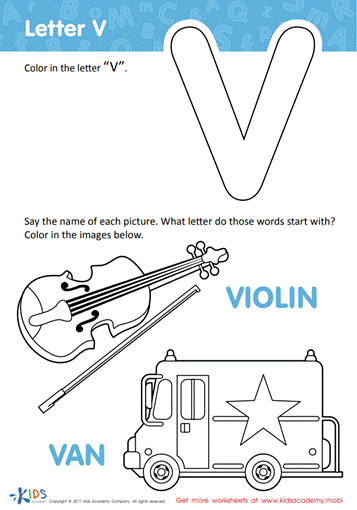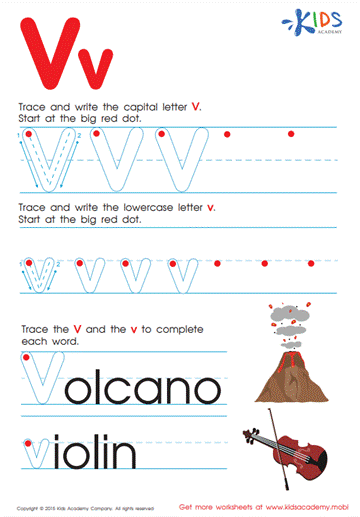-
English
-
English Pre-K
-
Unit 1: Early Literacy Skills
-
ABCs
- Pre-writing Activities
- Letter A
- Letter B
- Letter C
- Letter D
- Letter E
- Letter F
- Letter G
- Letter H
- Letter I
- Letter J
- Letter K
- Letter L
- Letter M
- Letter N
- Letter O
- Letter P
- Letter Q
- Letter R
- Letter S
- Letter T
- Letter U
- Letter V
- Letter W
- Letter X
- Letter Y
- Letter Z
-
Phonological Awareness
- Rhyming Words
- Letter Sounds B, C, D, and F
- Letter Sounds G, H, J, and K
- Letter Sounds L, M, N, and P
- Letter Sounds Q, R, S, and T
- Letter Sounds V, W, X, Y, and Z
- Letter Sounds A, E, and I
- Letter Sounds O and U
- Beginning Sounds
- Matching Letters to Sounds
-
ABCs
-
Unit 2: Vocabulary
-
Common Words
- Sorting Words into Categories
- Color Words
- Verbs and Adjectives
-
Sight Words
- Sight Words 'I' and 'Can'
- Sight Words 'You' and 'Like'
-
Common Words
-
Unit 3: Print Awareness
-
Parts of a Book
- Working with a Book
- Spaces Between Words
- Text and Illustrations
-
Picture Books and Poems
- Picture Book Text Features
- Poem Text Features
- Signs and Labels in the Community
-
Parts of a Book
-
Unit 4: Reading Literature
- Questions About Stories
- Discussing Stories
-
Unit 5: Reading Informational Texts
- Retelling Details in a Text
- Questions About a Text
- Connections Between Events
- Text Features
- Describing Illustrations
-
Unit 1: Early Literacy Skills
-
English Pre-K
-
Math
-
Math for Pre-Kindergarten
-
Logic and Geometry
-
Matching and Sorting
- Same and Different
- Which One Is a Little Different?
- Objects That Go Together
- Sorting by Color and Size
- Sorting The Same Group in Different Ways
- Patterns
-
Shapes
- Shapes in Our Environment
- Naming Shapes Regardless of Size
- Making Shapes in Preschool
- Comparing Shapes
- Relative Positions
- Sorting Shapes
-
Matching and Sorting
-
Early Number Sense
-
Numbers 1–5
- Counting to 3
- Counting to 5
- Arranging Objects up to 3 Objects
- Arranging up to 5 Objects
- Writing Numbers 1–5
-
Numbers 1–5
-
Numbers up to 10
- Counting to 10
- Arranging up to 10 Objects
- Number 0
- Writing Numbers 6–10
- Breaking Down Numbers 6-10
-
Logic and Geometry
-
Math for Pre-Kindergarten
Letter V
If you're reading this article, it means you've reached the letter V on your alphabet journey. This letter is so straightforward it can be made with only two diagonal lines. One of the first steps you might find helpful is displaying the letter on the "Letter of the Week" board where you can draw or print out the letter Vand pin it on the board. Offering this visual queue throughout the week helps your child retain it in their long term memory. You can also try to introduce the letter in a fun way, for example, you can point out that the car produces the sound V when it goes "Vroom".
You can also offer your child an activity a day for a week to make the process of learning more fun. But first, make use of this Kids Academy educational Letter V video that introduces your child to the name, shape, and sound of this letter using captivating animations.
Activities
- Letter V Coloring Sheet: You can offer your child this Kids Academy coloring worksheet to get them acquainted with how the letter V looks and sounds. It allows them to deploy their creativity by giving them the freedom to color in whatever way they’d like, while maintaining the focus on the letter V and words that start with it such as 'van' and 'violin'.

- Letter V Tracing Page: You can also make use of this Kids Academy Letter V tracing worksheet to encourage the development of your child’s pre-writing skills. Tracing the letter V in uppercase and lowercase is a great way for learning the letter while training the motor skills associated with writing.

- Velcro V: On a piece of cardboard, have your child cut and pin velcro strips to make a letter V. Make sure you’re closely supervising your child while they use scissors to cut and tacks to pin the velcro. In addition to the educational benefits of this activity, trusting your child with using these “dangerous” tools also helps build their confidence.
- V is for Vase: For this activity, print out a big bubble letter V. Help your child make some flower cut-outs and place them inside the letter V to make it look like a vase holding a bouquet.
- Volcano Experiment: This activity requires more effort than the others, but it is a kids favorite! You can choose one of two routes, the easy one or the hard one. For the hard one, you’ll need to build a volcano out of plaster or clay. You’ll need to make the whole of the volcano big enough to fit a small container like a baby food jar. In the container, have your child add two spoons of baking soda, a spoon of dish soap, and some red and yellow food coloring. Then for the eruption, they’ll need to add an ounce of vinegar and enjoy! For the easier version, you can skip the first step and perform the same experiment using only the container as the volcano.
With these activities, your child will learn the letter V in no time. Once they are done with this letter, you’ll need to start teaching the letter W. If you need some support planning your letter W lesson plan, visit the Kids Academy website for more material similar to the ones found in this article.

